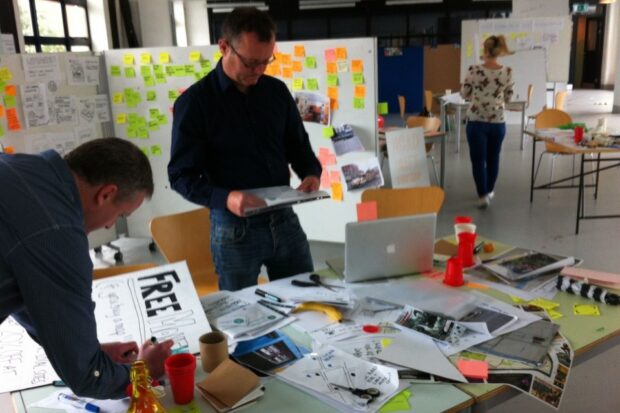Policy Lab is bringing design thinking to Government. It's about connecting civil servants with outside design experts and upskilling civil servants themselves. Following a really successful collaborative workshop on police digitization where Sean Miller ran an excellent prototyping session, I thought I had better learn how to do it myself, and went back to school to a service design masterclass at the National College of Art and Design in Dublin.
There are more photos on the tumblr of the three days.
Magic moments
At the start of the three days, we were asked to think of a really great service. People suggested things from Airbnb, Halo and Amazon – services that met a need, and that were good value, convenient and easy to use. And bad services? Airlines that delivered you to an airport that was not your destination (twice), telecoms companies that passed you from department to department and public services that were delivered without an ounce of empathy.
Services do not exist on their own; they are co-created with a user. Taxis or hotels cannot work without customers, nor a health service without patients. They are made up of different interactions – or touchpoints – between the user and the service. Service design makes sure these are ‘magic moments’ and not ‘points of pain’.
It works by observing, experiencing and mapping out how people use a service, using this and other creative skills to come up with an idea for a new or improved service and then prototyping it – mocking it up, trying it out and getting feedback to develop it further.
Hitting the streets of Dublin
As it is all about designing by doing, it was no surprise that we were expected to learn by doing. At the start of the course we were set the brief to develop a new off the beaten track experience for tourists visiting Dublin. Three days later, there were four proposals for new services, which had already made a total of £105. I had also met and worked with some fascinating people and learned a lot about service design tactics:
- Prototyping and trying something out helps you improve the idea. Often ideas can remain as powerpoint presentations for a long time before turning into an expensive pilot which may or may not be successful. Prototyping – whether that be creating a paper app to flick through with customers or role playing how a user might experience a new service – is a really great way of trying something out, learning what works and getting some quick feedback to refine the idea. My group’s idea was a local currency that you earned by visiting points of interest in the working class Liberties neighbourhood, which you could then spend in local shops and cafes. By mocking up a coin (the bottom of a plastic cup) and going to test the concept with tourists, we quickly realized that tourists did not like the idea of changing currency (twice) to something they could only spend in a very local area, but were prepared to buy something. So we created something with value – a map of local landmarks – which we could sell, with some local currency thrown in.
- Sketching has a real value. When an idea is written down or described verbally, people can often conjure up different images in their mind. Drawing it provides a much clearer picture which is great for making sure everything is on the same page. When we sketched out a conversation between tourists and a tourism advisor, it was clear that I thought we were marketing at alternative-experience-seeking junkies, and others thought our market was kids with families.
- More people x diverse experience = better ideas. Creative thinking can happen by thinking laterally, or looking at things from different perspectives. In a similar way to the police digitization workshop mentioned earlier, the course was made up of a really diverse group of people from graphic designers to customer service managers to policymakers. Everyone brought great inspiration to the table from their professional and personal lives. Someone in our group played the Geocaching game, another had developed a local currency for another part of Dublin and I love maps!
- Speaking to real people is not that scary. Policymakers are very good at engaging with stakeholders and practitioners, but we often leave engagement with service users to our research colleagues. Why is that? Well, proper ethnographic work is a research profession. But it’s also quite a scary thought of approaching someone in the street and asking them their opinion about something, particularly if it is your own idea. But with a friendly smile on my face, the reaction was not as bad as I had feared. People like being asked their opinion, and their feedback helped us co-design a better tourist proposal.
The week provided me with great new skills, experience of how you apply them to a real-life problem, and a great network of Irish designers. I’ll be able to use them as we enter the police digitization or family mediation projects, or when we go to talk to departmental policy schools about user-centred and service design.
What other skills could be taught in a practical 'summer school' session? Leave a comment below or join in on Twitter with Policy Lab or Open Policy.

1 comment
Comment by Chris Atherton posted on
This is great! I would love to see a version where civil servants and policy people work through a brief designed to help them to improve their understanding of content design and language for the general public. It's important that ordinary people understand the contracts and legal agreements they undertake with government, but it's very easy for subject-matter experts in government to overlook that accuracy and exhaustive detail may be 'right', but can be hard to understand.